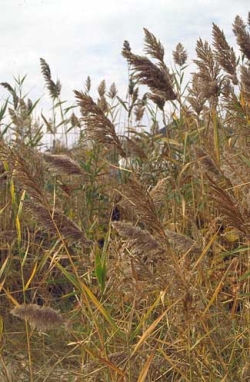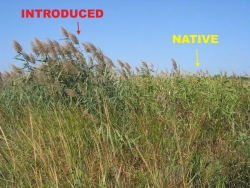
Phragmites australis
Photo Courtesy
Plant Conservation Alliance
Alien Plant Working Group
As found on
nps.gov/plants/alien/fact/phau1.htm
Photographers credited on Factsheet
 Invasive Phragmites vs. Native
Invasive Phragmites vs. Native
Photo Courtesy
Plant Conservation Alliance
Alien Plant Working Group
As found on
nps.gov/plants/alien/fact/phau1.htm
See guide to distinguish
Invasive from Native plants
Photographers credited on Factsheet
Hi, this is Mark Larese-Casanova from the Utah Master Naturalist Program at Utah State University Extension.
When exploring wetlands, streambanks, and the shores of Great Salt Lake this time of year, it’s common to see tall grasses, over ten feet high, blowing in the breeze. While it is very abundant, the common reed known as Phragmites australis is anything but normal.
Phragmites was introduced from Europe over a century ago, and is now found in all 50 states and on every continent except Antarctica. It can grow to more than 15 feet in height, with long blade-like leaves. It flowers from July to October, producing dense, feathery clusters of small flowers that are purple while flowering and turn light brown after producing seeds. Each stem can produce up to 2,000 wind-dispersed seeds that are particularly effective at colonizing new areas. Because of this, Phragmites can take over a disturbed area quickly and prevent native plants, such as bulrush and cattail, from becoming established.
Like other invasive plants, Phragmites is successful at outcompeting native plants. Once a plant is established from seed, Phragmites spreads quickly through rhizomes, or underground stems, that can produce many additional stalks. While Phragmites may start growing among other wetland plants, it quickly outcompetes them for nutrients and sunlight. However, the native “Phragmites australis subspecies americanus” does not grow nearly as dense or tall, and tends to not be invasive.
Because introduced Phragmites can quickly grow into solid stands, it can greatly reduce plant diversity in wetlands, ultimately reducing the quality of wildlife habitat. Wetlands along the shore of Great Salt Lake are particularly important habitat for many migratory birds species, some of which occur here in the largest populations in North America or the world. The rapid takeover by Phragmites in these wetlands could eventually have dramatic impacts to the entire Great Salt Lake ecosystem.
In order to combat this threat, wetland managers have tried several methods for controlling or removing Phragmites, including spraying with herbicide, burning, livestock grazing, and mowing. Dr. Karin Kettenring, a Utah State University researcher, and her graduate students are currently studying the effects of several of these Phragmites control methods along the shores of Great Salt Lake. By experimenting with the timing of mowing and herbicide treatment, as well as covering mowed Phragmites with heavy black plastic, Dr. Kettenring and her team hope to find the most effective combination of treatments. With the continual conversion of native wetland habitats to a monoculture of Phragmites, Dr. Kettenring’s research is of particular importance to maintaining the health of the Great Salt Lake ecosystem- one of our state’s greatest natural wonders.
For Wild About Utah, I’m Mark Larese-Casanova.
Credits:
Images: Courtesy & Copyright
Jil M. Swearingen, National Park Service, Center for Urban Ecology, Washington, DC
Dr. Kristin Saltonstall, Adjunct Research Scientist, Horn Point Laboratory,
University of Maryland Center for Environmental Science, Solomon, MD
Robert Meadows, Environmental Scientist, North DE Wetland Rehabilitation Program,
DE Mosquito Control Section, Newark, DE
As found on https://www.nps.gov/plants/alien/fact/phau1.htm
Text: Mark Larese-Casanova, Utah Master Naturalist Program at Utah State University Extension.
Additional Reading:
Evans K, Martinson W (2008) Utah’s featured birds and viewing sites: a conservation platform for Important Bird Areas and Bird Habitat Conservation Areas. Salt Lake City, Utah
Kulmatiski A, Beard KH, Meyerson LA, Gibson JR, Mock KE (2010) Nonnative Phragmites australis invasion into Utah wetlands. Western North American Naturalist 70:541-552
Long, A.L., C.M.U. Neale, and K.M. Kettenring. 2012. Management of Phragmites in the Great Salt Lake watershed. Final report to the Utah Department of Natural Resources, Division of Forestry, Fire & State Lands. 15 pp.
